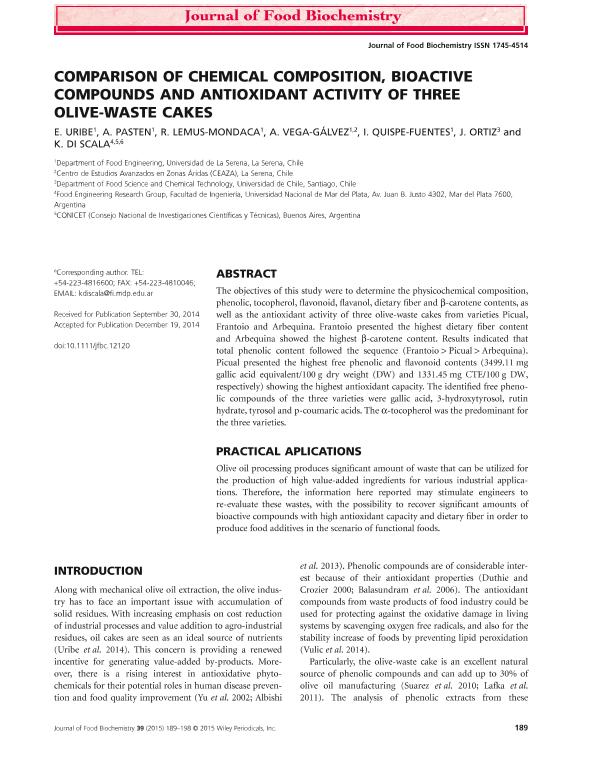Mostrar el registro sencillo del ítem
dc.contributor.author
Uribe, E.
dc.contributor.author
Pasten, A.
dc.contributor.author
Lemus Mondaca, R.
dc.contributor.author
Vega Gálvez, A.
dc.contributor.author
Quispe Fuentes, I.
dc.contributor.author
Ortiz, J.
dc.contributor.author
Di Scala, Karina Cecilia

dc.date.available
2018-02-27T16:00:18Z
dc.date.issued
2015-04
dc.identifier.citation
Uribe, E.; Pasten, A.; Lemus Mondaca, R.; Vega Gálvez, A.; Quispe Fuentes, I.; et al.; Comparison of Chemical Composition, Bioactive Compounds and Antioxidant Activity of Three Olive-Waste Cakes; Wiley Blackwell Publishing, Inc; Journal Of Food Biochemistry; 39; 2; 4-2015; 189-198
dc.identifier.issn
0145-8884
dc.identifier.uri
http://hdl.handle.net/11336/37258
dc.description.abstract
The objectives of this study were to determine the physicochemical composition, phenolic, tocopherol, flavonoid, flavanol, dietary fiber and β-carotene contents, as well as the antioxidant activity of three olive-waste cakes from varieties Picual, Frantoio and Arbequina. Frantoio presented the highest dietary fiber content and Arbequina showed the highest β-carotene content. Results indicated that total phenolic content followed the sequence (Frantoio>Picual>Arbequina). Picual presented the highest free phenolic and flavonoid contents (3499.11mg gallic acid equivalent/100g dry weight (DW) and 1331.45mg CTE/100g DW, respectively) showing the highest antioxidant capacity. The identified free phenolic compounds of the three varieties were gallic acid, 3-hydroxytyrosol, rutin hydrate, tyrosol and p-coumaric acids. The α-tocopherol was the predominant for the three varieties. Practical Aplications: Olive oil processing produces significant amount of waste that can be utilized for the production of high value-added ingredients for various industrial applications. Therefore, the information here reported may stimulate engineers to re-evaluate these wastes, with the possibility to recover significant amounts of bioactive compounds with high antioxidant capacity and dietary fiber in order to produce food additives in the scenario of functional foods.
dc.format
application/pdf
dc.language.iso
eng
dc.publisher
Wiley Blackwell Publishing, Inc

dc.rights
info:eu-repo/semantics/openAccess
dc.rights.uri
https://creativecommons.org/licenses/by-nc-sa/2.5/ar/
dc.subject
Chemical Composition
dc.subject
Bioactive Compounds
dc.subject
Antioxidant Activity
dc.subject
Olive Waste Cakes
dc.subject.classification
Alimentos y Bebidas

dc.subject.classification
Otras Ingenierías y Tecnologías

dc.subject.classification
INGENIERÍAS Y TECNOLOGÍAS

dc.title
Comparison of Chemical Composition, Bioactive Compounds and Antioxidant Activity of Three Olive-Waste Cakes
dc.type
info:eu-repo/semantics/article
dc.type
info:ar-repo/semantics/artículo
dc.type
info:eu-repo/semantics/publishedVersion
dc.date.updated
2018-02-27T14:17:03Z
dc.journal.volume
39
dc.journal.number
2
dc.journal.pagination
189-198
dc.journal.pais
Reino Unido

dc.journal.ciudad
Londres
dc.description.fil
Fil: Uribe, E.. Universidad de la Serena; Chile
dc.description.fil
Fil: Pasten, A.. Universidad de la Serena; Chile
dc.description.fil
Fil: Lemus Mondaca, R.. Universidad de la Serena; Chile
dc.description.fil
Fil: Vega Gálvez, A.. Universidad de la Serena; Chile
dc.description.fil
Fil: Quispe Fuentes, I.. Universidad de la Serena; Chile
dc.description.fil
Fil: Ortiz, J.. Universidad de Chile; Chile
dc.description.fil
Fil: Di Scala, Karina Cecilia. Consejo Nacional de Investigaciones Científicas y Técnicas; Argentina. Universidad Nacional de Mar del Plata. Facultad de Ingeniería; Argentina
dc.journal.title
Journal Of Food Biochemistry

dc.relation.alternativeid
info:eu-repo/semantics/altIdentifier/doi/http://dx.doi.org/10.1111/jfbc.12120
dc.relation.alternativeid
info:eu-repo/semantics/altIdentifier/url/http://onlinelibrary.wiley.com/doi/10.1111/jfbc.12120/abstract
Archivos asociados
